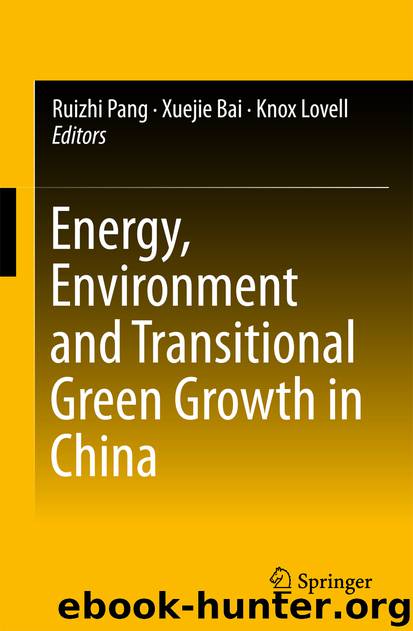Energy, Environment and Transitional Green Growth in China by Ruizhi Pang Xuejie Bai & Knox Lovell

Author:Ruizhi Pang, Xuejie Bai & Knox Lovell
Language: eng
Format: epub
Publisher: Springer Singapore, Singapore
4 Conclusions
Under the framework of a macro total factor production function, this paper selects relevant theories on environmental production technology as a starting point to explore the allocations of carbon and sulfur emissions. An output-oriented model is initially used to describe the total factor production process. We place carbon and sulfur emissions into the production process in the form of undesirable outputs, a ZSG efficiency distribution model is then established by combining the ZSG-DEA approach and environmental production technology. Using mathematical software to solve the programming problem, the distribution schemes of China’s carbon and sulfur emissions are analyzed. This paper focuses on the calculation of ZSG efficiency based on 2010 historical data, as well as evaluates and compares the differences between administrative allocation, ZSG allocation, and actual emissions. We also offer an optimal proposal for China’s carbon and sulfur emissions allocation in 2015. The following conclusions are drawn.
First, China’s Central Government adopts an allocation scheme of “one size fits all” to set emissions-reduction target, leading to a malpractice of “whipping the fast and hardworking” but “rewarding the slow and freeloading.” Therefore, some provinces (Tianjin, Qinghai, Hainan, and others with higher sulfur emissions efficiencies) must struggle to fulfill their administrative targets, whereas other provinces (Shanxi, Shaanxi, Hunan, and others with greater emissions but lower efficiencies) can easily meet their targets. This leads to provinces with significant emissions (including Guizhou, Inner Mongolia, and Xinjiang) lagging further behind. In contrast, the ZSG allocation scheme, based on the emissions efficiency of all provinces and cities, emphasizes the overall Pareto optimal and simultaneously considers economic, environmental, and energy factors, thereby leading to widely ranging administrative allocation results. After the ZSG reallocation in 2015, 11 provinces obtain higher sulfur quotas than that in the administrative allocation, whereas 19 other provinces continue their emissions reduction apart from their administrative quotas. The latter are primarily resource-oriented provinces, so it is more difficult for them to realize the ZSG reduction target under their present economic structure; however, they can purchase emissions right from other provinces.
Second, comparisons between the administrative allocation of China’s Central Government and the ZSG allocation show that provinces and cities with high emissions efficiency were generally assigned higher reduction targets by the government than that under the ZSG allocation, whereas provinces with lower emissions efficiency were assigned lower administrative emissions reduction targets. As for regional distribution, the western region was the most inefficient in terms of sulfur emission, but the government implemented an administrative protection that is not conducive to narrowing the gap between the east and west. Therefore, the government should adjust the current administrative scheme and offer necessary incentives. Based on the Pareto optimality of efficiency, this paper introduces the allocation of carbon and sulfur emissions into a total factor production framework to demonstrate that, although carbon and sulfur emissions are inevitable with economic outcomes, they can be controlled more effectively and reasonably than in the traditional administrative allocation scheme.
Because the allocation of emissions right involves many crucial issues in various dimensions, such as
Download
This site does not store any files on its server. We only index and link to content provided by other sites. Please contact the content providers to delete copyright contents if any and email us, we'll remove relevant links or contents immediately.
International Integration of the Brazilian Economy by Elias C. Grivoyannis(87869)
The Radium Girls by Kate Moore(11895)
Turbulence by E. J. Noyes(7915)
Nudge - Improving Decisions about Health, Wealth, and Happiness by Thaler Sunstein(7525)
The Black Swan by Nassim Nicholas Taleb(6981)
Rich Dad Poor Dad by Robert T. Kiyosaki(6350)
Pioneering Portfolio Management by David F. Swensen(6204)
Man-made Catastrophes and Risk Information Concealment by Dmitry Chernov & Didier Sornette(5896)
Zero to One by Peter Thiel(5657)
Secrecy World by Jake Bernstein(4615)
Millionaire: The Philanderer, Gambler, and Duelist Who Invented Modern Finance by Janet Gleeson(4343)
The Age of Surveillance Capitalism by Shoshana Zuboff(4178)
Skin in the Game by Nassim Nicholas Taleb(4140)
Bullshit Jobs by David Graeber(4050)
The Money Culture by Michael Lewis(4048)
Skin in the Game: Hidden Asymmetries in Daily Life by Nassim Nicholas Taleb(3900)
The Dhandho Investor by Mohnish Pabrai(3674)
The Wisdom of Finance by Mihir Desai(3625)
Blockchain Basics by Daniel Drescher(3468)
